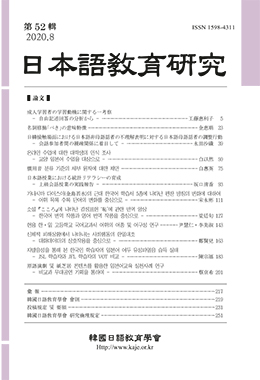본고는 한국과 일본에서 2020년 현재 사용하고 있는 고등학교 국어교과서 어휘의 어종(語種) 및 어구성(語構成)에 주목하여, 이를 『分類語彙表』(1964)에 의거하여 의미분포상의 특징과 관련지어 분석하고, 역으로 의미범주별로 어종 및 어구성을 분석함으로써, 언어학적, 의미론적 관점에서 양국 교과서 어휘의 특징을 밝히는 것을 연구 목적으로 한다.
연구방법으로서는 카이제곱 검정을 통해 유의차를 산정하여 대조하였다. 양국의 교과서 어휘는 개별어수에서는 유사한 특징을 보이나 전체어수에서는 차이가 크게 나타났다. 전체어수의 경우, 한국은 어종에서는 한자어와 혼종어, 어구성에서는 복합어의 비중이 높고 더불어 구성성분이 3개 이상인 경우가 상대적으로 많았다. 한편, 일본은 어종에서는 고유어와 외래어, 어구성에서는 단일어 및 파생어의 비중이 높고, 한국에 비해 접두사의 사용량이 많았다.
5개 의미분야별로 보면 양국 모두 <1.5자연물 및 자연현상>, <1.1추상적 관계>에서는 고유어, <1.3인간활동-정신 및 행위>에서는 한자어 비중이 높다. 특히, 전자는 일본, 후자는 한국의 비중이 상대적으로 높다. <1.4생산물 및 도구>에서는 한국은 한자어, 일본은 고유어 비중이 높다. 어구성에서 양국은 5개 의미분야 모두 단일어의 비중이 높고, 특히 일본이 상대적으로 높다. 파생어 및 복합어는 양국 모두 <1.4> 및 <1.2인간활동의 주체>에서 비중이 높고, 특히 한국이 상대적으로 높다. 이상을 통해, 양 어휘의 의미분포와 언어적 특성이 맞물리면서 어종 및 어구성에서 양국 간 차이가 나타나고 있음을 확인하였다.
This study examines the word types and word structure of the vocabulary in national language textbooks currently used in 2020 for high schools in Korea and Japan, and analyzes them in terms of the characteristics of the semantic distribution according to Bunruigoihyou (1964). This study also aims to analyze the word structure and word types according to the categories of meaning in order to explicate the characteristics of the school textbooks of the two countries. As for research method, chi-squared test was used to calculate significant differences and compare them.
The textbook vocabulary of both countries shows similar characteristics in the number of individual words, but the difference in the total number of words is great. The analysis of the total number of words shows that Korean textbooks have a high proportion of Chinese characters and hybrid words in word types, and compound words in word structure, with relatively more words that consist of at least three components. On the other hand, Japanese textbooks have a high proportion of native words and loanwords in word types, and simple words and derivatives in word structure, and use more prefixes than Korean textbooks.
The analysis of word types by five areas of meaning shows that textbooks of both countries have a high proportion of native words in < 1.5 Natural Objects > and < 1.1 Abstract Relations >, and a high proportion of Chinese characters in < 1.3 Human Activities >. Particularly, the former is high in Japan and the latter high in Korea. In < 1.4 Products >, Korean textbooks have a high proportion of Chinese characters and Japanese textbooks have a high proportion of native words. Textbooks of both countries show a high proportion of derivatives in <1.4> and < 1.2 The Subject of Human Activities >. Analysis of the word structure by areas of meaning shows that simple words have the highest proportion in both countries, and Japan is higher than Korea. In Korea, the use of compound words and derivatives is relatively high in <1.2> and <1.4>. Derivatives in Japan also have the highest proportion in <1.2>. This result can be interpreted that the linguistic characteristics and the semantic distribution of the two languages interlock with each other.




